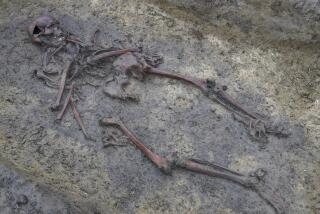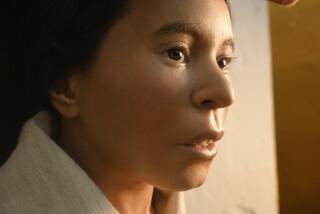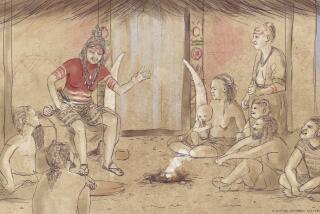British sites yield mummies, but no King Tuts as found in Egypt
- Share via
Archaeologists have found evidence of mummies in England.
Specifically, they found mummified remains in seven Bronze Age burial sites located throughout the British Isles.
The findings, published Wednesday in the journal Antiquity, suggests the art of mummification may have been more widespread in ancient Britain than was previously thought.
Just to be clear, the mummies of Britain are not the same as the Egyptian mummies you might be imagining.
The researchers define mummification as “the preservation of bodily soft tissue via natural processes...or artificial means.”
A natural mummification process might be putting a corpse in a preservative environment such as a peat bog. An artificial way to achieve the same effect is embalming or smoking.
“There are many ways to mummify a body,” said Thomas Booth, a post-doctoral researcher at the Museum of Natural History in London and the first author on the paper.
Also, keep in mind that the British climate is not nearly as conducive to the preservation of soft tissue as the hot dry Egyptian desert. Therefore, the mummies of England and Scotland look more like skeletons than their Egyptian counterparts. This makes it hard to determine which bones may have belonged to bodies that had been deliberately preserved based on sight alone.
To understand where and when mummification might have taken place in ancient Europe, Booth and his collaborators put samples of 307 bones from 26 archaeological sites under a microscope.
After examining the bones of known mummies from Yemen and Ireland, they were able to show that centuries-old mummified bones look different than bones from bodies that have not been mummified.
The reason is a little gross. There is evidence that when a person dies, the gut bacteria escapes from the body and starts breaking down soft tissue including the interior microstructure of the bones, Booth said. This process is known as putrefaction.
However, if a body is preserved immediately after death, the putrefaction process does not have time to get started and the microstructure of the bones stays intact.
“With most archaeological bones we see extensive microscopic tunneling,” said Booth. “But mummified bones show little to no tunneling.”
The vast majority of bones the team looked at did have lots of tunneling, but more than half of the bones from skeletons dug up on the British Isles and dated to the Bronze Age (2000 to 750 B.C.) had just a little bit of tunneling, suggesting they had been mummified.
The researchers say that mummification in the Bronze Age was hardly uniform.
Some of the bones looked a little burnt, suggesting the body had been smoked over a fire to preserve it. Other corpses may have been put in peat bogs and pulled out later. Still others may have had all their organs cut out soon after death to keep putrefaction at bay.
“It looks like people were taking advantage of their natural resources to produce these preserved bodies,” Booth said.
In addition, mummified bones were found yards away from non-mummified bones in the same archaeological sites, suggesting that just an elite few got the mummy treatment.
Booth completed this work while getting his Ph.D at Sheffield University in England. For now, he is not sure entirely sure what the motivation was for preserving the dead in Bronze Age British culture, but he said it seemed clear that it was different from what the Egyptians were doing.
“In Egypt, after a body was mummified, it was locked away in tombs, and never seen again,” he said. “In the Bronze Age in Britain, mummies were kept above ground and still had an active role in living society.”
Science rules! Follow me @DeborahNetburn and “like” Los Angeles Times Science & Health on Facebook.







